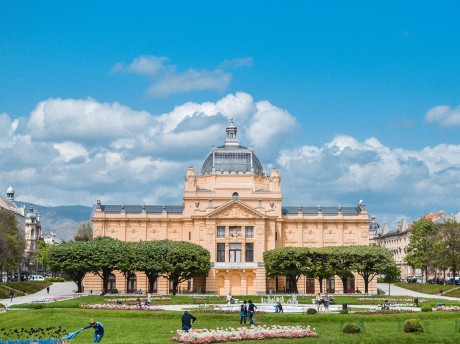Croatia, Slovenia and Italy: Zagreb, Ljubljana, Trieste, Venice & Rome
Your adventure begins in Zagreb, the Croatian capital with a Roman, Byzantine and Austro-Hungarian past. Visit the iconic Gothic Zagreb Cathedral, Zagreb City Museum and St. Mark's church. Take the train to Ljubljana, Slovenia's capital. The Ljubljana castle, Dragon bridge, Tivoli Park, Ljubljana Cathedral and the National Gallery, all glow with lively colours. Predjama Castle, built within a cave mouth, and Postojna Cave are nearby attractions.
Read more
Your adventure begins in Zagreb, the Croatian capital with a Roman, Byzantine and Austro-Hungarian past. Visit the iconic Gothic Zagreb Cathedral, Zagreb City Museum and St. Mark's church. Take the train to Ljubljana, Slovenia's capital. The Ljubljana castle, Dragon bridge, Tivoli Park, Ljubljana Cathedral and the National Gallery, all glow with lively colours. Predjama Castle, built within a cave mouth, and Postojna Cave are nearby attractions. Your next stop is Trieste, the vibrant Italian port city with historical charm. Then on to Venice, the world's most romantic city. At St. Mark's Square, St. Mark's Basilica, a masterpiece of Byzantine architecture and its neighbour, the Gothic Doge's Palace are incredible. A gondola ride through the winding canals of Venice allows you to experience the city's unique charm and a day trip to the nearby islands of Murano, Burano, and Torcello to see the famous glass-making factories and colorful houses is a must. Complete your tour in Rome. The Vatican, Colosseum, Castel St Angelo, Palatine Hill, Trevi Fountain and other monuments will amaze. Waterviews strives to offer accommodation options within walking distance of water and/or in an area of touristic interest. Our prices include taxes (but excludes local tourist taxes). Customize your trip to your personal preferences with optional activities (hit the “Add Activities’’) or change hotels, etc. Contact us for customization at no extra cost at: Service@waterviewstravel.com
Destinations
- Zagreb
- Ljubljana
- Trieste
- Venice
- Rome
Itinerary
Zagreb
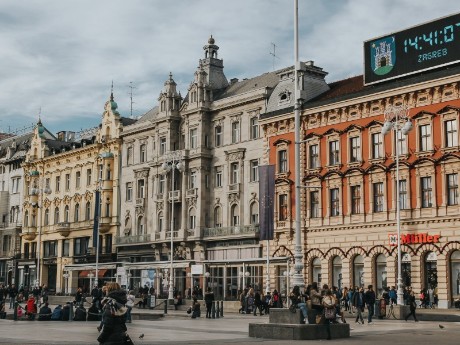
Croatia's vibrant capital is a bustling hub of history and culture, attracting flocks of crowds who come to marvel at its stunning architecture and enjoy its lively atmosphere. The city’s Upper Town is a picturesque sight of medieval cobbled streets that are filled with ancient churches, charming cafes and quaint bars, and the lower district is Zagreb’s buzzing centre where sprawling squares and wide boulevards house excellent shops, world-class museums and an impressive collection of 18th and 19th century Austro-Hungarian buildings.
Read more
Croatia's vibrant capital is a bustling hub of history and culture, attracting flocks of crowds who come to marvel at its stunning architecture and enjoy its lively atmosphere. The city’s Upper Town is a picturesque sight of medieval cobbled streets that are filled with ancient churches, charming cafes and quaint bars, and the lower district is Zagreb’s buzzing centre where sprawling squares and wide boulevards house excellent shops, world-class museums and an impressive collection of 18th and 19th century Austro-Hungarian buildings.
Additional Information
Zagreb is a vibrant city of around 800,000 people (metropolitan area: 1,200,000). The city boasts a charming medieval 'old city' with architecture and cobbled streets reminiscent of Vienna, Budapest, Prague and other Central-European capitals. In 2017 it was visited by over a million tourists, mainly from Austria, Germany and Italy. Zagreb is also well known for its Advent festival, which occurs from December to early January, boasting vibrant nightlife and extra events not available in other parts of the year.
Tourist information
Other information points are located at the airport, bus station, railway station and at the Lotrščak Tower.
© Sourced from Wikivoyage
Ljubljana
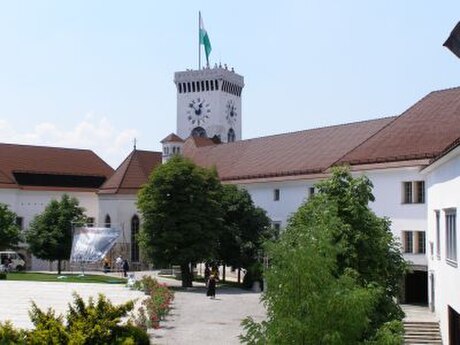
Ljubljana ("lyoo-blah-nah"), the capital of Slovenia, is a charming old city full of artists, museums, and galleries. In Roman times, it was called Colonia Iulia Aemona and was part of Province X "Venetia et Histria" of Italia proper. With a population of 300,000, it is one of the smallest capital cities in Europe. Ljubljana is pronounced similar to 'ljubljena' ('beloved') in Slovenian, but the words are not related.
Read more
Ljubljana ("lyoo-blah-nah"), the capital of Slovenia, is a charming old city full of artists, museums, and galleries. In Roman times, it was called Colonia Iulia Aemona and was part of Province X "Venetia et Histria" of Italia proper. With a population of 300,000, it is one of the smallest capital cities in Europe. Ljubljana is pronounced similar to 'ljubljena' ('beloved') in Slovenian, but the words are not related.
Additional Information
Ljubljana has no world-famous attractions, which is just great: there's no need to hop from one place to another, taking photos and crossing off the items on your checklist. You have all the time to stroll around and enjoy the city itself. Ljubljana is noted as one of the greenest capitals in Europe; a pair of green hills, one of them sporting the city's major attraction (Ljubljana Castle) approach the centre like two opposing wedges, so forest with an extensive network of footpaths is literally across the street from the old town.
In the summer, its centre hosts a number of city sponsored events, from children's workshops and public playgrounds on the streets that get closed for traffic for the occasion, to Trnfest's off-beat street performances and musical events of all genres. In autumn it shows its academic face as it fills again with students of the state's largest university to whom the city owes much of its youthful character. Cold December days are warmed by thousands of lights, the New Year's decorations conceived by local artists, and by food and drinks sold from street stands on the banks of the Ljubljanica river. After surviving the boring grey remaining of winter, the city erupts again with spring flowers planted on its streets and crossroads.
Orientation
The Ljubljanica river flows through the centre of town, past Baroque buildings and under the ramparts of the ancient castle on the hill. The new city and modern-day commercial core lies to the west of the river, while the old city and the castle are located on the east side of the river. Many bridges cross the river, the most famous of which is the Tromostovje (triple) bridge, designed by architect Jože Plečnik.
© Sourced from Wikivoyage
Trieste
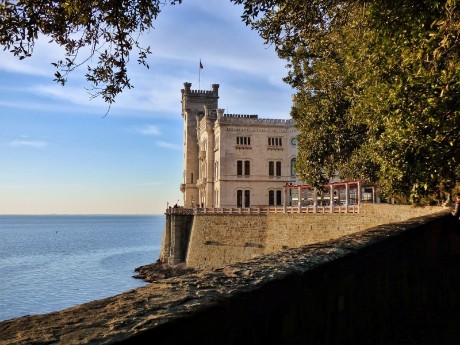
With a setting on Italy's Adriatic coast, close to the Slovenian border, Trieste has a unique charm and culture that's hard to find elsewhere in the country. The melting pot of cultures is apparent upon hearing the local dialect - a mix of Italian, German, Slovenian and Greek - and is reflected in the city's architecture, featuring remnants of its Roman and Austro-Hungarian past and reminders of its importance as a port town. Stroll along the banks of the boat-lined Grand Canal and the elegant waterfront and Trieste is sure to enchant you.
Read more
With a setting on Italy's Adriatic coast, close to the Slovenian border, Trieste has a unique charm and culture that's hard to find elsewhere in the country. The melting pot of cultures is apparent upon hearing the local dialect - a mix of Italian, German, Slovenian and Greek - and is reflected in the city's architecture, featuring remnants of its Roman and Austro-Hungarian past and reminders of its importance as a port town. Stroll along the banks of the boat-lined Grand Canal and the elegant waterfront and Trieste is sure to enchant you.
Additional Information
Trieste is the capital of the autonomous region of Friuli Venezia Giulia and has over 204,000 inhabitants (2018). It is at the crossroads of several commercial and cultural flows: German middle Europe to the north, Slavic masses and the Balkans to the east, Italy and then Latin countries to the west and the Mediterranean Sea to the south.
Its artistic and cultural heritage is linked to its singular "border town" location. You can find some old Roman architecture (a small theatre near the sea, a nice arch into old city and an interesting Roman museum), Austrian empire architecture across the city centre (similar to stuff you can find in Vienna) and a nice atmosphere of metissage of Mediterranean styles, as Trieste was a very important port during the 18th century.
© Sourced from Wikivoyage
Venice
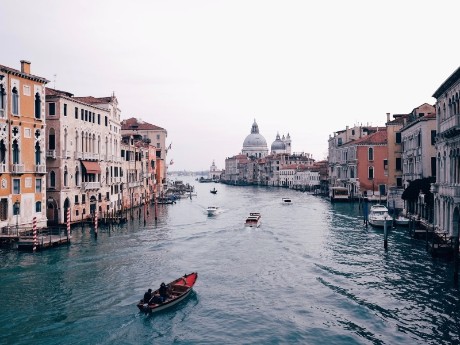
Venice is an icon across the world due to its picturesque canals, black gondolas and unique Venetian Gothic architecture, and the city certainly lives up to its image with a romantic charm that dazzles everyone who visits. The Grand Canal, lined with Renaissance and Baroque palaces, is a sight to behold, and the bustling Piazza San Marco is the lively hub of the city. Yet Venice is much more than its main attractions; delve into its backstreets and winding alleys and you'll discover ancient churches, charming local restaurants and vibrant bars.
Read more
Venice is an icon across the world due to its picturesque canals, black gondolas and unique Venetian Gothic architecture, and the city certainly lives up to its image with a romantic charm that dazzles everyone who visits. The Grand Canal, lined with Renaissance and Baroque palaces, is a sight to behold, and the bustling Piazza San Marco is the lively hub of the city. Yet Venice is much more than its main attractions; delve into its backstreets and winding alleys and you'll discover ancient churches, charming local restaurants and vibrant bars.
Additional Information
Orientation
The comune (municipality) of Venice is made up of numerous islands in the Venetian Lagoon as well as a stretch of terraferma (mainland) in northern Italy. The comune is divided into six boroughs, the most famous of which (known as Venezia Insulare) comprises the historic city of Venice as well as the islands of Giudecca, Murano, Burano, Torcello, Mazzorbo, and Sant'Erasmo. Lido and Mestre are other popular areas of the comune.
The historic city is divided into six sestieri (districts): Cannaregio, Castello, Dorsoduro, San Polo, Santa Croce, and San Marco, where the main monuments and sights are. Each sestiere uses separate house numbers, however, they are not allocated in a specific pattern.
History
The Most Serene Republic of Venice dates back to 827, when a Byzantine Duke moved its seat to what is now known as the Rialto, and for the following 970 years, it prospered on trade (especially from the Silk Road) and under the rule of a Roman-style Senate headed by the Doge. Eventually, the Republic of Venice grew into a powerful city-state, and the cradle of Italian renaissance. In the late 15th century, the Ottoman Empire's expansion around the Mediterranean, new routes on the high seas shifted commerce to the Atlantic, demoting Venice's political status.
The city remains a centre for the arts. One of the significant events in the history of Venice was the opening of the first public opera house in 1637, which allowed members of the general public (those who could afford to pay for the tickets) to enjoy what was once court entertainment reserved for the aristocracy, thus allowing the genre of opera to flourish. Venice was an important destination of the Grand Tour from the 17th century. In 1797, the city was conquered by Napoleon, a blow from which it never recovered. The city was soon absorbed into Austria-Hungary, then ping-ponged back and forth between Austria and a nascent Italy, but Venice is still a monument to the glory days of the Renaissance, and historical culture still throbs powerfully in the old Italians' veins.
Climate
July and August may be the worst time to visit: it's sometimes very hot and often humid, there are mosquitoes and occasional infestations of flies, and there are a lot of tourists and large crowds anywhere you go. Spring and autumn are probably best, a compromise between temperature (expect 5-15°C in March) and the tourist load. Between November and January, you may manage to feel you have Venice all to yourself, an interesting and quiet experience. Beware of the weather during the winter months: it can be quite cold, windy, and damp. Fog is an additional hazard if you are driving in or out, doubly so in the unlikely chance that you will pilot a boat. But if you've never been to Venice, it's better to go in summer than not to go. You won't regret it. Many cities are far worse in summer. Although Venice has no cars, diesel motors used by boats contribute to less than slar air quality.
Acqua alta (high water) has become a fact of life in Venice. The lagoon water level occasionally rises above the level of the squares and streets, flooding them. This can happen several times a year, at irregular intervals, usually in the colder months. Acqua alta usually lasts a few hours and coincides with high tide. You'll see raised walkways in side alleys ready to be pulled out when acqua alta hits. When the city begins to flood, sirens will sound to warn residents and businesses. If you speak fluent Italian, tune into news programs since their predictions of the times the flood begins and ends are usually accurate. Normally, the tide rises and falls in six-hour cycles.
You can get an acqua alta map at the tourist offices either at the railway station or St Mark's Square. This will show you the higher, dry routes and the ones with walkways set up during the various flood alerts. There is a tide measuring station at the Rialto vaporetto piers, and a noticeboard at the base of the Campanile in the Piazza San Marco that shows a live tide reading and predictions for the next few days.
© Sourced from Wikivoyage
Rome
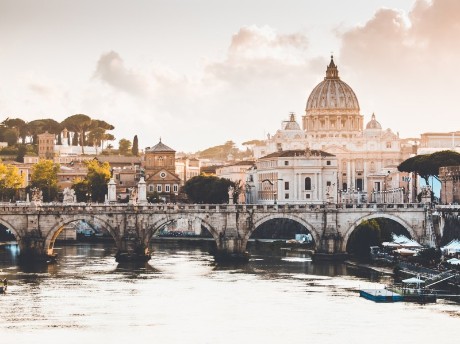
From the ancient walls of the Colosseum and the magic of the Trevi Fountain to the gilded churches of the Vatican City and the views from its seven hills, Rome is truly a dream. Stroll through the vibrant streets and you’ll get a taste for the city’s incredible past and rich culture, with ancient churches, Roman ruins and opulent fountains on every corner. And the city not only offers sightseeing - do as the locals and meander in piazzas, sample incredible street food and stop for an evening aperitivo to really experience la dolce vita.
Read more
From the ancient walls of the Colosseum and the magic of the Trevi Fountain to the gilded churches of the Vatican City and the views from its seven hills, Rome is truly a dream. Stroll through the vibrant streets and you’ll get a taste for the city’s incredible past and rich culture, with ancient churches, Roman ruins and opulent fountains on every corner. And the city not only offers sightseeing - do as the locals and meander in piazzas, sample incredible street food and stop for an evening aperitivo to really experience la dolce vita.
Additional Information
Situated on the River Tiber, between the Apennine Mountains and the Tyrrhenian Sea, the "Eternal City" was once the administrative centre of the mighty Roman Empire, governing a vast region that stretched all the way from Britain to Mesopotamia. Today it remains the seat of the Italian government and home to numerous ministerial offices. Rome has 2.7 million inhabitants while the metropolitan area is home to around 4.5 million.
Architecturally and culturally, Rome has some contrasts - you have areas with pompously huge majestic palaces, avenues and basilicas, which are then surrounded by tiny alleyways, little churches and old houses. The centre of Rome is mainly ancient, and modern buildings are usually concentrated in the suburbs, unlike Milan (where new and old architecture is combined both in the centre and the outskirts). You may also find yourself walking from a grand palace and tree-lined elegant boulevard, into a small and cramped Medieval-like street.
The abbreviation "S.P.Q.R" is ubiquitous in Rome, short for the old democratic motto "Senatus Populusque Romanus" (Latin), i.e. "The Roman Senate and People".
For two weeks in August, many of Rome's inhabitants shut up shop (literally) and go on their own vacations; many stores, restaurants and other amenities will be closed during this time. The temperature in the city centre at this time of year is not particularly pleasant. If you do travel to Rome at this time, be prepared to see Chiuso per ferie (Closed for holidays) signs on many establishments. Even in these weeks the city is very beautiful and if you are looking for a less overcrowded vacation in Rome, this is not a bad time. You will always be able to find somewhere to eat.
History
Rome's history spans over two and half thousand years, which have seen its transformation from a small Latin village to the centre of a vast empire, through the founding of Catholicism, and into the capital of today's Italy. Rome's history is long and complex. What follows is merely a quick summary.
Rome is traditionally thought to have been founded by the mythical twins Romulus and Remus, who were abandoned as infants in the Tiber River and raised by a mother wolf before being found by a shepherd who raised them as his own sons. Rome was founded as a small village sometime in the 8th century BC surrounding the Palatine Hill, including the area where the Roman Forum is found. Due to the village's position at a ford on the Tiber River, Rome became a crossroads of traffic and trade.
The settlement developed into the capital of the Roman Kingdom, led by a series of Etruscan kings, before becoming the seat of the Roman Republic at around 500 BC, and then the centre of the Roman Empire from 27 BC on. For almost a thousand years, Rome was the largest, wealthiest, most powerful city in the Western World, with dominance over most of Europe and the Mediterranean Sea. Even after the fall of the Roman Empire in the 5th century AD, Rome maintained considerable importance and wealth.
Beginning with the reign of Constantine I, the Bishop of Rome (later known as the Pope) gained political and religious importance, establishing Rome as the centre of the Catholic Church. During the Early Middle Ages, the city declined in population but gained a new importance as the capital of the newly formed Papal States. Throughout the Middle Ages, Rome was a major pilgrimage site and the focus of struggles between the Holy Roman Empire and the Papacy.
With the Italian Renaissance fully under way in the 15th century, Rome changed dramatically. Extravagant churches, bridges, and public spaces, including a new Saint Peter's Basilica and the Sistine Chapel, were constructed by the Papacy so that Rome would equal the grandeur of other Italian cities of the period. As the Grand Tour became customary for young European gentlemen in the 17th century, Rome became an important tourist destination, and remains as such until today.
In the 19th century, Rome again became the focus of a power struggle with the rise of the Kingdom of Italy, which wished to see a reunification of Italy. The Papal States remained in control of Rome under French protection, but with the outbreak of the Franco-Prussian War of 1870, French troops were forced to abandon Rome, leaving it clear for the Kingdom of Italy to capture. Rome became the capital of Italy, and has remained such ever since.
Rome today is a contemporary metropolis that reflects the many periods of its long history - Ancient times, Middle Ages, the Renaissance and the Modern Era. With the rise of Italian Fascism following World War I, Rome's population grew. This trend was stopped by World War II, which dealt relatively minor damage to Rome. With the dismantlement of the monarchy and the creation of the Italian Republic following WWII, Rome again began to grow in population and became a modern city. The city stands today as the capital of Italy and one of the world's major tourist destinations.
Climate
Rome has a Mediterranean climate, with hot, dry summers and mild, wet winters. In the winter months, daytime temperatures are usually pleasant and range from 10-15 °C, while nighttime temperatures tend to stay slightly above freezing. That being said, the occasional cold snap can cause temperatures to fall below freezing, and it is not unheard of for light flurries of snow to fall on occasion, though accumulation is rare, and major snowstorms are known to occur once every 20-25 years.
Background reading
At last count there were close to 1700 novels set in Rome in days gone by. Most easily available in bookshops are those by [http://lindseydavis.co.uk/ Lindsey Davis and Steven Saylor. Both are good storytellers and excellent at portraying life in Ancient Rome. Particularly interesting if you are visiting Rome may be Saylor’s Roma: The Novel of Ancient Rome, which traces the first thousand years or so of Rome’s history by following the fictional fortunes of two families. Each chapter begins with a map showing the state of Rome’s development at the time of the chapter.
The classic work on Ancient Rome remains Edward Gibbon’s History of the Decline and Fall of the Roman Empire. This was written in 1782 but is still being reprinted. A marvelous book that covers Rome’s fortunes from Romulus and Remus to the 1970s is Rome: The Biography of a City by Christopher Hibbert (Penguin). An excellent guide book, too, although perhaps a bit too heavy to carry around. Rome by Robert Hughes (Orion Books) concentrates on the city's art history and provides fascinating insights into the things you will see while walking around. SPQR, written by Cambridge University professor and British TV personality Mary Beard, and published in 2015, offers a detailed analysis of Rome's first 1000 years and attempts to answer why Rome expanded from a small village on the Tiber to the centre of a major empire.
English-language bookshops in Rome are: The Lion Bookshop, Via dei Greci, 36, close to Piazza di Spagna. Lots of books and a small cafe. Anglo-American Bookstore, Via delle Vite, 102, also close to Piazza di Spagna. A large store, with specialist sections. Strong on non-fiction. The Almost Corner Bookshop, Via del Moro 45, Trastevere. Small but very well-stocked store on the other side of the river. Some Italian bookstores also have English-language sections. Try the large selection of English books (but also French, Spanish and more) at Feltrinelli International in via Vittorio Emanuele Orlando - or the smaller selection at its store in Largo Argentina.
© Sourced from Wikivoyage




